


Piranesi, in contrast, refuses to treat it as “a sort of riddle to be unravelled” but resides happily in a place he finds “enough in and of Itself”. Lacking Piranesi’s faith and innocence, he considers the House as a trove of “Great and Secret Knowledge” hidden, like treasure, somewhere within it. The Other, a pedantic, self-important scholar of some kind, possesses a small “shining device” and enters data into it. As for the Vestibule, it harbours not only “eight massive Statues of Minotaurs” (now there’s a warning to the Reader) but a nasty draught that brings “a smell of rain, metal and petrol”. They include “old fish-finger packets and sausage-roll wrappings”. Piranesi reveres his home as a self-sufficient universe that satisfies all needs and answers all questions: “The Beauty of the House is immeasurable its Kindness infinite.”Įven in his narration, though, we spot alien intrusions. For its first two-thirds, however, we must find our meanings within the House itself. Piranesi, too, dwells from time to time on margins, portals and thresholds, and on the tantalising idea of “a door between us and wherever magic had gone”. In 2007, Clarke revisited the edgelands between reason and magic in the stories of The Ladies of Grace Adieu. That novel made the formal barriers between fantasy, historical and “literary” fiction vanish as if crumbled by a spell, as did (in her virtuoso pastiche) the stylistic fences between Jane Austen and early Dickens. In 2004, Susanna Clarke published Jonathan Strange & Mr Norrell, her epic, learned, playful tale of rival Regency magicians in a beautifully confected parallel England. We have waited a long time to meet Piranesi. This dapper, irascible, middle-aged fusspot in neatly tailored outfits scolds and bullies Piranesi when they meet (“Can we not do this now? I’m trying to get this ritual sorted.”) He, who subsists on fish caught from the swelling seas on its lower levels, still lives and breathes. Piranesi believes that fifteen humans have existed in the House, and thus the World. Partial skeletons, which he curates and cherishes, endure among the statues as tokens of prior human habitation. Birds of various species fly through and nest in the House Piranesi dates this journal to “the Year the Albatross came to the South-Western Halls”. Clouds in the upper galleries breed rain and mist seas – and sometimes tidal floods – wash through its nether regions the Middle Halls between are “the Domain of birds and of men”. The House, which is “for all practical purposes identical” with “the World”, has its own climate. “It will be an honour to open the doors to the House, and show its beauty to the world.Piranesi’s favourites include “the Gorilla, the Young Boy playing the Cymbals, the Woman carrying a Beehive, the Elephant carrying a Castle, the Faun, the Two Kings playing Chess”. “But when I followed Piranesi into his watery Halls, I discovered Susanna’s wit, strangeness and sorrow made new and beautiful in ways I could not have imagined,” she said. “Susanna hinted she may be writing again after such a long hiatus, but I never really believed a fully imagined world, a perfectly constructed novel, would just be sitting there,” said Geller.Ĭlarke’s UK editor, Alexandra Pringle, said that she had thought that Jonathan Strange, which “appeared from the ether like an apparition … couldn’t be equalled”. Since then, the British author has published only a collection of short stories set in the same universe, The Ladies of Grace Adieu, telling interviewers that persistent ill-health had slowed her down.Ĭlarke’s agent, Jonny Geller, said that there are “a few moments in an agent’s life when something so unexpected and so wonderful pops up in your inbox, you can’t quite believe it”.

Published in 2004, it took the world by storm, selling more than 4m copies, winning prizes including the Hugo and World Fantasy awards, and was adapted by the BBC in 2015. Running to more than 1,000 pages, it is set in an alternative version of 19th-century England, where magic has almost – but not quite – faded into the past. Clarke’s debut, Jonathan Strange and Mr Norrell, took her more than 10 years to write.


 0 kommentar(er)
0 kommentar(er)
